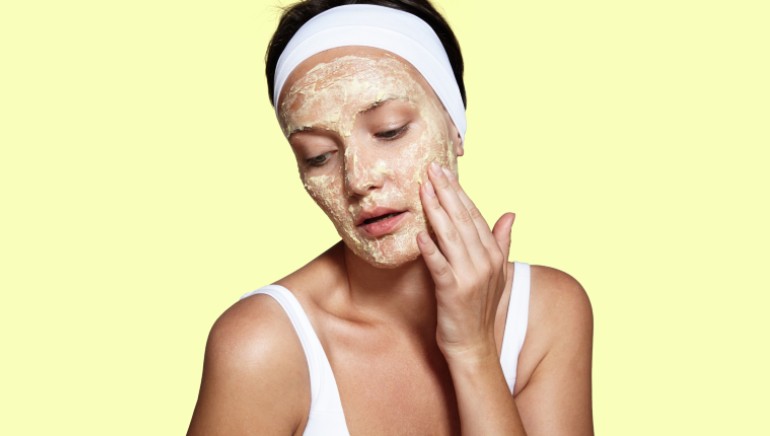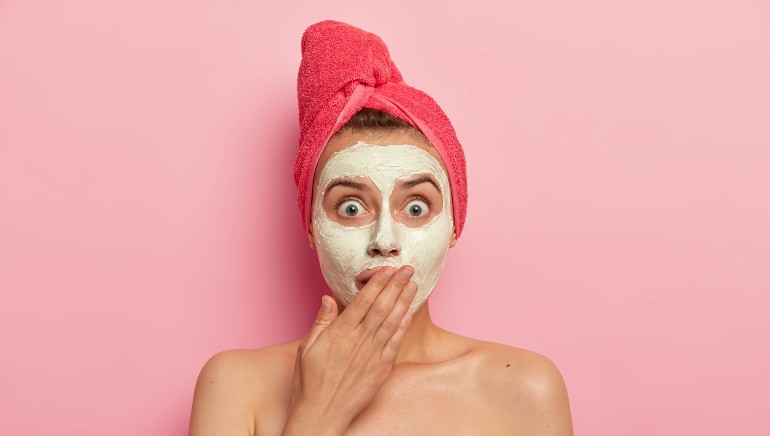
This clay mask is the most natural way to get a non-greasy skin!
8 months ago | 105 Views
Clay is an effective skincare ingredient, which is why it is widely used in beauty products. Its main job is to absorb excess oils and prevent acne. So, people with oily skin or those who struggle with pimples, blackheads or whiteheads will find clay very beneficial. As for individuals with dry skin, it is best to use it less, as clay can further dry out skin. If you want to include clay in your skincare routine, you can try clay face masks. From Fuller's Earth or multani mitti to Bentonite clay, there are many options when it comes to clay masks for skin. So, pick the best clay face mask according to your skin needs.
What is a clay mask?
Clay masks are crafted from various types of clay known for their ability to absorb oil and impurities. Their aim is to leave the skin clearer and more refreshed, says dermatologist Dr Pawan Singh.
Typically used to combat acne and promote a firmer, youthful appearance, clay masks vary in composition, often distinguished by their pH levels or potential of hydrogen, which measures the acidity or alkalinity of a substance. Our skin naturally maintains a slightly acidic pH between 4 and 6, whereas clay masks generally possess an alkaline pH that exceeds 7. This alkalinity helps balance the skin's acidity, aiding in the removal of pore-clogging oils and giving a temporary tightening effect on the skin.

A 2023 study published in the Skin Research and Technology journal showed the clay mask's efficiency in managing oily skin, and acne. Researchers also found clay masks to be effective in improving hydration and skin texture.
What are the common types of clay masks for skin?
Here are some of the popular types of clay masks:
1. Bentonite clay
Ideal for acne-prone and oily skin, bentonite clay is derived from volcanic ash. It can absorb oil, dirt, and bacteria, while also tightening the skin and reducing inflammation due to its antibacterial properties, says the expert. Its pH sits at around 8.5.
2. French green clay
Best suited for sensitive skin, French green clay, also known as sea clay, can detoxify and heal. It's beneficial for soothing allergies, sunburns, insect bites, and wounds due to its anti-inflammatory properties. This clay, which has a pH of 7.75, also acts as an exfoliator, promoting improved blood circulation.
3. Kaolin clay
This clay's pH is 5.5, but even if it is close to our skin's natural pH, it manages to draw out impurities from the pores. The clay, which has mild astringent properties, may be beneficial for people with oily skin and acne-prone skin types.
4. Fuller's Earth (Multani mitti)
Popular in Indian households, Fuller's Earth or Multani mitti is excellent for oily, dull, and pigmented skin, says the expert. It absorbs excess oil, acts as a mild bleach, and helps fade blemishes, scars, hyperpigmentation, and discoloration. The clay mask with 7.5 pH, also leaves a cooling and soothing sensation on the skin.
5. Rhassoul clay
This type of clay may help get rid of blackheads, improve skin tone, and leave the skin soft, smooth, and radiant. Rhassoul clay has a pH of around 7.5, and has great oil absorption properties, so it is good for those with oily skin.
6. Red clay
Clay masks are usually good for people with oily skin. But those with dry skin can go for red clay. When the red clay hardens, it forms a film that may help skin to retain moisture, as per a 2016 study published in Revista de Ciências Farmacêutica Básica e Aplicadas. If you have dry skin, use it just once per week, as clay masks have the potential to dry out skin.
Can clay masks remove tan?
Here’s how clay masks can potentially help with tan:
1. Exfoliation
Many clay masks, especially those containing kaolin clay or French green clay, have mild exfoliating properties, says Dr Singh. Exfoliation helps remove dead skin cells, which can contribute to an uneven tan. By promoting cell turnover, clay masks can gradually lighten tan lines and spots.
2. Detoxification
Clay masks can draw out impurities and excess oil from the skin. This cleansing action can help to refresh the skin and potentially lighten the appearance of tan lines or patches.
But for significant tan removal, especially if it's a stubborn or deep tan, other treatments like exfoliating scrubs, chemical peels, or professional skincare treatments may be more effective.

Can you use a clay mask everyday?
Using a clay mask daily may not be suitable for everyone, as it can potentially be too harsh for certain skin types. Clay masks are known for their ability to absorb excess oil and impurities from the skin, which can be advantageous for oily or acne-prone skin when used occasionally. However, frequent application of a clay mask can lead to dryness, irritation, or over-stripping the skin of its natural oils, says the expert. It is generally recommended to apply a clay mask 1 to 2 times per week, taking into account your specific skin type. If you have sensitive or dry skin, you may opt to use a clay mask less often, such as once a week.
How to use clay masks?
Using a clay mask effectively involves a few key steps:
- Use a gentle cleanser to remove any make-up, dirt, or oil buildup before applying the clay mask.
- Use clean fingertips or a mask applicator brush to apply an even layer of the clay mask to your face, but avoid the delicate skin around your eyes and lips.
- Most clay masks require about 10 to 15 minutes to dry and work effectively. As the mask dries up, you may feel a tightening sensation on your skin. This is normal and indicates that the clay is absorbing excess oil and impurities.
- Once the clay mask gets completely dry, rinse it off with water. Use a soft washcloth or your hands to help remove the mask, using gentle circular motions.
- After removing the clay mask, pat your face dry with a clean towel then use a lightweight, non-comedogenic moisturiser to replenish hydration and lock in moisture.
What are the side effects of a clay mask?
Using clay masks excessively or leaving them on for extended periods can lead to dryness and irritation of the skin. So, use these masks no more than twice a week to avoid these effects, says the expert. Also, be mindful of the ingredients in clay masks, especially if you have sensitive skin. Some formulations may include substances like glycolic acid that could potentially irritate your skin further.
Clay masks are good for skin, as they can remove impurities and prevent acne. But monitor how your skin responds to figure out the best frequency and duration of use for you.
Read Also: boost your immune system: 10 foods to increase the intake of vitamin c in your body





















